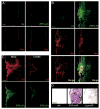PTPsigma is a receptor for chondroitin sulfate proteoglycan, an inhibitor of neural regeneration
- PMID: 19833921
- PMCID: PMC2811318
- DOI: 10.1126/science.1178310
PTPsigma is a receptor for chondroitin sulfate proteoglycan, an inhibitor of neural regeneration
Abstract
Chondroitin sulfate proteoglycans (CSPGs) present a barrier to axon regeneration. However, no specific receptor for the inhibitory effect of CSPGs has been identified. We showed that a transmembrane protein tyrosine phosphatase, PTPsigma, binds with high affinity to neural CSPGs. Binding involves the chondroitin sulfate chains and a specific site on the first immunoglobulin-like domain of PTPsigma. In culture, PTPsigma(-/-) neurons show reduced inhibition by CSPG. A PTPsigma fusion protein probe can detect cognate ligands that are up-regulated specifically at neural lesion sites. After spinal cord injury, PTPsigma gene disruption enhanced the ability of axons to penetrate regions containing CSPG. These results indicate that PTPsigma can act as a receptor for CSPGs and may provide new therapeutic approaches to neural regeneration.
Figures




References
MeSH terms
Substances
Grants and funding
LinkOut - more resources
Full Text Sources
Other Literature Sources
Medical
Molecular Biology Databases

